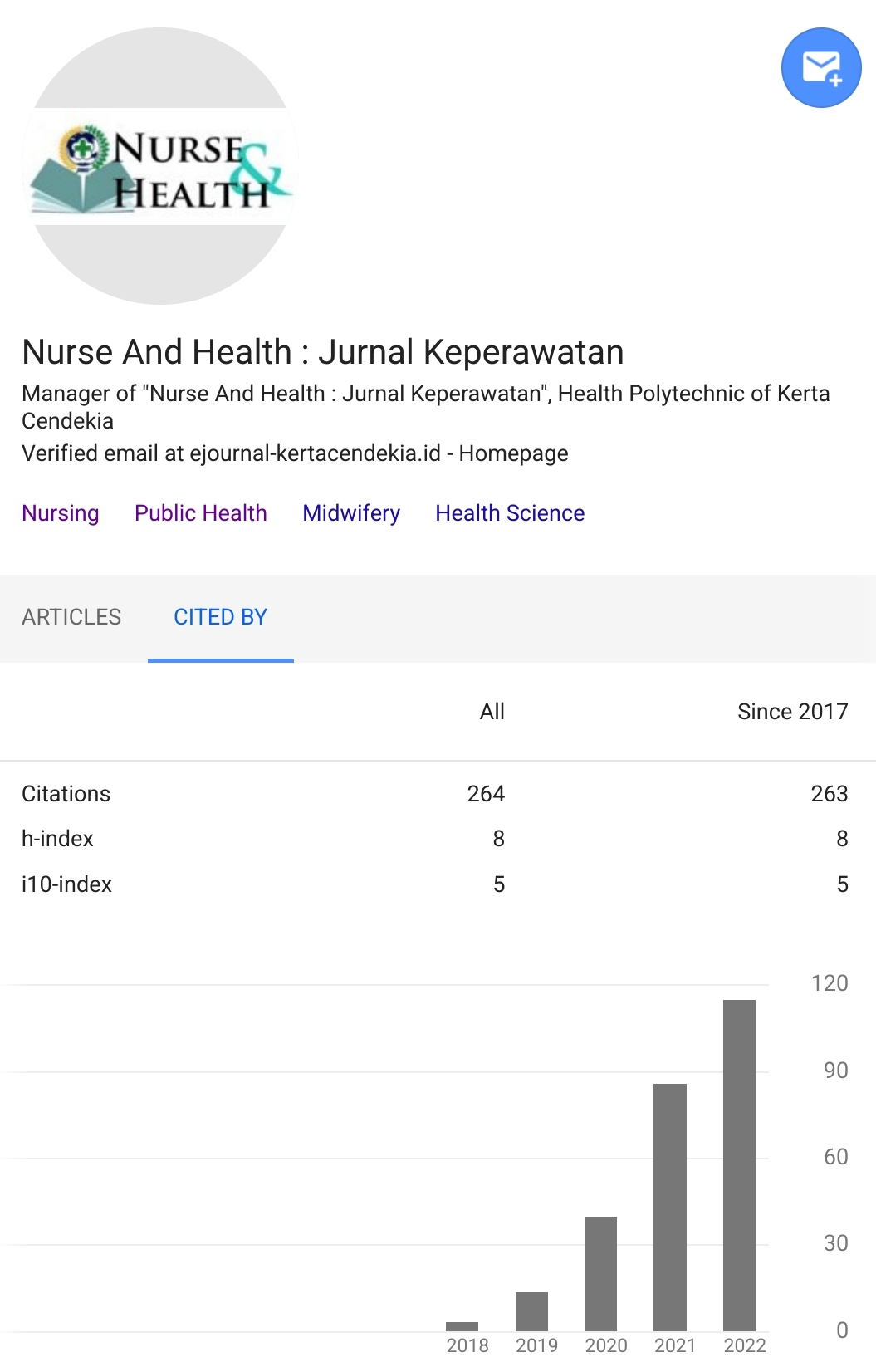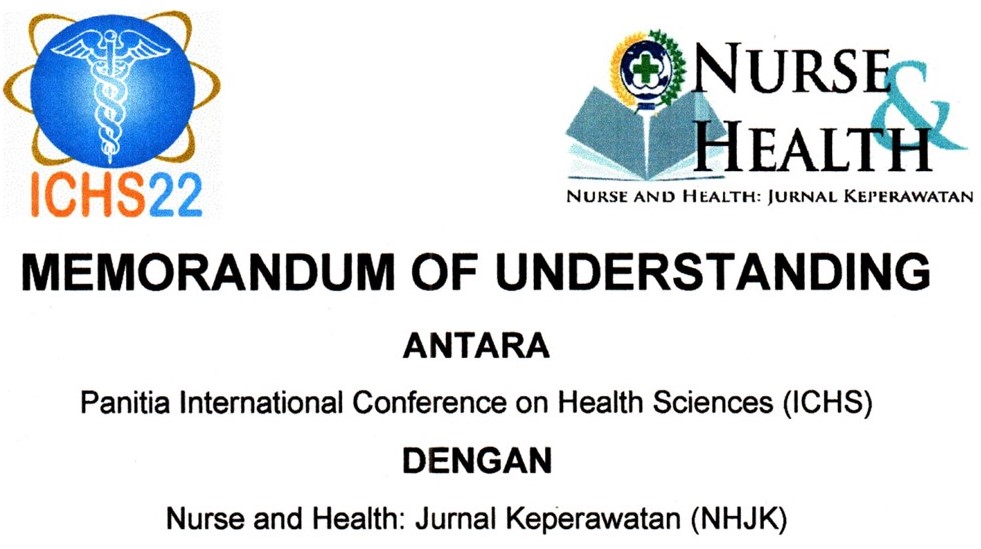THE EFFECTIVENESS OF DIETS PROGRAM FOR PREECLAMPSIA ON BLOOD PRESSURE CONTROL AMONG PREGNANT WOMEN IN SOUTH TANGERANG
Abstract
Background: Preeclampsia is one of three causes of death for pregnant women, contributed to about 27% of maternal mortality in Indonesia. One of intervention that can be made for pregnant women to handling preeclampsia is diet for preeclampsia. Objectives: The purpose this study was to investigate the effectiveness of diets program for preeclampsia on decreasing blood pressure in pregnant women. Methods: A pre-experimental design with one group pretest posttest was carried out. Population was all pregnant women who experience preeclampsia in Public Health Center in Ciputat South Tangerang. Twenty pregnant women who met criteria and completed the intervention were included in this study by using purposive sampling. Researcher explained the program diet and participants received program diets for preeclampsia in the form of a food list table, and fill in a table of food they consumed every day. Sphygmomanometer to measure blood pressure was used. Data collection with measure blood pressure was performed three times, before intervention, two weeks after diet program and one month after diet program. Repeated Measures ANOVA was applied to analysis with ? = 0.05. Results: The mean scores of Systolic blood pressure was 147.06; 143.81; 140.38 in first, second and third collection, respectively. Systolic blood pressure in pregnant women with preeclampsia significantly decreased within two weeks after intervention (F = 31.30; p-value = 0.0001; Eta Squared= 0.676). The mean score of diastolic blood pressure was 102.31, 99.00 and 91.56 respectively. Diastolic blood pressure within two weeks after intervention decreased (F= 19.05; p-value= 0.0001; Eta Squared= 0.560). Conclusion: Diets Programs for Preeclampsia could decrease both systole and diastole blood pressure. The recommendation for pregnant women who have Preeclampsia is to manage preeclampsia diets regularly.Downloads
References
Cunningham, Gery F. (2016). Obstetri Williams Edisi 23, Vol. 2. Jakarta: EGC.
Devita, Hendri dan Amran, Vitri Yuli Afni (2016). 'Hubungan Kadar Magnesium dengan Kejadian Preeklampsi pada Ibu Hamil Trimester III di RSUP Dr. M. Djamil Padang Tahun 2015'.
Ekaputra, VG. (2014). Perbedaan Kadar Soluble Endoglin Serum dan Ekspresi Endoglin Placenta pada Preeklampsia/Eklampsia dan Kehamilan Normotensi. Program Pendidikan Dokter Spesialis 1 Obstetri & Ginekologi Semarang: Fakultas Kedokteran Universitas Diponegoro Semarang.
Kementerian Kesehatan Republik Indonesia. (2014). Pusat Data dan Informasi Kementerian Kesehatan Republik Indonesia.
Kementerian Kesehatan Republik Indonesia. (2015). Profil Kesehatan Indonesia Tahun 2015.
Kementerian Kesehatan Republik Indonesia. (2017). Profil Kesehatan Indonesia Tahun 2017.
Khusen, D & Polin, A. (2012). Factors Influencing Maternal Mortality from Severe Preeclampsia and Eclampsia. Maj Obstetry Ginekolog. Indonesia.
Lalenoh, Diana Christine. (2018). Preeklampsia Berat dan Eklampsia: Tatalaksana Anastesa Perioperatif. Yogyakarta: Deepublish.
Leifer, G. (2015). Introduction to Maternity and Pediatric Nursing, Seventh Edition. Missouri: Elsevier.
Mafikasari, A & Kartikasari, R A. (2015). Posisi Tidur dengan Kejadian Back Pain (Nyeri Punggung) pada Ibu Hamil Trimester III. Jurnal Keperawatan Padjadjaran.
Parul S. (2012). Benefit of Vitamin D supplementation in Pregnancy for Prevention of Preeclampsia. Dept Of Biochemistry Pt. B.D. Sharma PGIMS, Rohtak, India.
Pujiani, Ira, et all (2017). 'Effect of Ambon Banana Consumption to Decrease Blood Pressure in Pregnant Woman with Preeclamps'.
Sibai BM and Ewell M, Levine RJ. (2017). Risk factors associated with preeclampsia in healthy nulliparous women, the Calcium for Preeclampsia Prevention (CPEP) Study Group. Am J Obstet Gynecology.
Tangkilisan LR, Kalangi S, Masi G. Pengaruh Terapi Diet Pisang Ambon (Musa Paradisiaca Var. Sapientum Linn) Terhadap Penurunan Tekanan Darah Pada Klien Hipertensi Di Kota Bitung. Jurnal Keperawatan. 2014.
Tripeni T, Sulisdiana S. (2015). Efektivitas Jus Pisang Dan Air Kelapa Muda Terhadap Tensi Lansia Penderita Hipertensi. Hospital Majapahit.
Villareal, H. (2008). Hypertension. United States of America : A Wiley Medical publication.
Weber MA, Schiffrin EL, White WB, Mann S, Lindholm LH, Kenerson JG, et all. (2014). Clinical Practice Guidelines For The Management Of Hypertension In The Community. The Journal Of Clinical Hypertension.
Whitney EN, Rolfes SR, Crowe T, Cameron-Smith D, Walsh A. (2011). Understanding Nutrition: Cengage Learning.
William dan Wilknis. (2013). Modern Nutritions In Health And Disease Tenth Edition. Wolters Kluwer Company. Philadelphia.
Mafikasari, A. & Kartikasari, R. A. (2015). Posisi Tidur Dengan Kejadian Back Pain (Nyeri Punggung) Pada Ibu Hamil Trimester III. Jurnal Keperawatan Padjadjaran.
Villareal, H. (2008). Hypertension. United States of America : A Wiley Medical publication.
Weber MA, Schiffrin EL, White WB, Mann S, Lindholm LH, Kenerson JG, et all. (2014). Clinical Practice Guidelines For The Management Of Hypertension In The Community. The Journal Of Clinical Hypertension.
Whitney EN, Rolfes SR, Crowe T, Cameron-Smith D, Walsh A. (2011). Understanding Nutrition: Cengage Learning.
William dan Wilknis. (2013). Modern Nutritions In Health And Disease Tenth Edition. Wolters Kluwer Company. Philadelphia.
Authors who publish with Nurse and Health: Jurnal Keperawatan agree to the following terms:
- Authors retain copyright licensed under a Creative Commons Attribution-NonCommercial 4.0 (CC BY-NC 4.0), which allows others to remix, tweak, and build upon the authors' work non-commercially, and although the others' new works must also acknowledge the authors and be non-commercial, they don't have to license their derivative works on the same terms.
- Authors are permitted and encouraged to post their work online (e.g., in institutional repositories or on their website) prior to and during the submission process, as it can lead to productive exchanges, as well as earlier and greater citation of published work (See The Effect of Open Access). Authors can archive pre-print and post-print or publisher's version/PDF.























